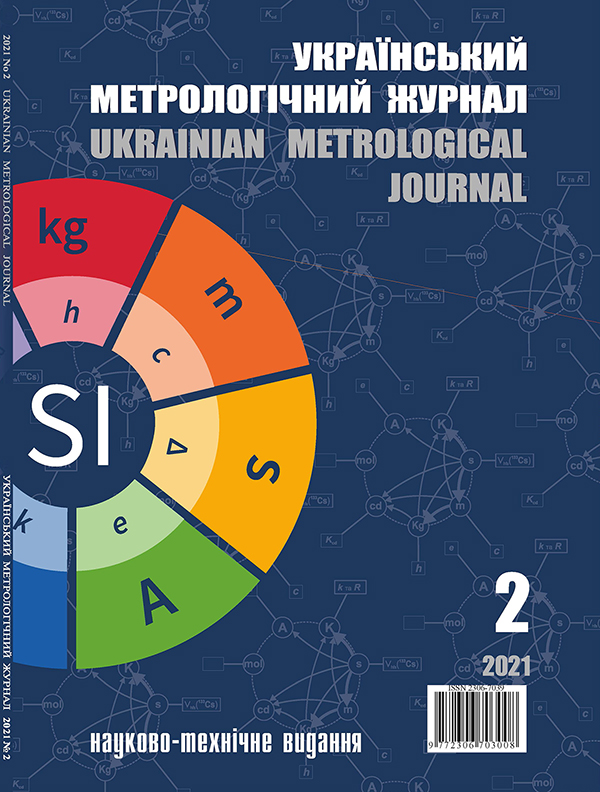Про неперервність та дискретність величин: приклади з фізики та метрології
DOI:
https://doi.org/10.24027/2306-7039.2.2021.236054Ключові слова:
безперервний; гранулярний; величина (англ. “quantity”); величина (англ. “magnitude”); кванти; ціле число; дійсне число; рахунок; функціяАнотація
У 3-му виданні Міжнародного словника з метрології (VIM3) величина визначається як “властивість явища, тіла або речовини”, залишаючи характеристики терміну “величина” (англ. “quantity”) пов’язаними із вибраними характеристиками відповідних властивостей. Виникає питання: чи повинна властивість також обов’язково мати відношення до можливої гранулярності явища, тіла або речовини?
Візьмемо, наприклад, величину “маса”: чи повинна вона завжди враховувати те, чи ділиться явище, тіло або речовина на окремі елементи? Це залежить від системи аналізу, а також від вибраної одиниці вимірювання. В інших випадках, таких як температура, макроскопічні властивості пов’язані зі статистичними властивостями гранулярних речовин, таких як атоми і молекули, тому нинішнє значення “температури” зазвичай втрачається на числовому рівні, де статистика елемента стає беззмістовною принаймні з експериментальної точки зору.
У статті розглядаються відмінності між неперервним та дискретним у фізиці, наводяться розбіжності тлумачення терміну “величина” у різних мовах. Висвітлено проблему вибору інструментів для обробки дискретності у складних випадках у математиці, квантовій фізиці та метрології.
Досліджено питання нескінченності у дискретному світі та точності. Зокрема, дискретність ставить під сумнів можливість допущення нескінченного числа елементів, матеріальних або математичних, наприклад “реальності дійсних чисел”, концепції, що досі є популярною у квантовій фізиці. Обґрунтовано необхідність зміни концепції точності та можливого обмеження “максимально можливої точності”.
У Додатку розглянуто підходи щодо можливих внутрішніх границь точності гранулярної одиниці маси.
Ключові слова: безперервний; гранулярний; величина (англ. “quantity”); величина (англ. “magnitude”); кванти; ціле число; дійсне число; рахунок; функція
Посилання
Leonard B. The mole is an Avogadro number of entities, the macroscopic unit for chemical amount. Accreditation and Quality Assurance, 2014, vol. 19(3), pp. 213–220. doi: https://doi.org/10.1007/s00769-014-1047-6
Johansson I. The mole is not an ordinary measurement unit. Accreditation and Quality Assurance, 2011, vol. 16(8), pp. 467–470. doi: https://doi.org/10.1007/s00769-011-0804-z
International vocabulary of metrology – Basic and general concepts and associated terms (VIM), 3rd edition. JCGM, 2012. Available at: https://www.bipm.org/documents/20126/2071204/JCGM_200_2012.pdf/f0e1ad45-d337-bbeb-53a6-15fe649d0ff1
Available at: https://www.bipm.org/en/bipm/mass/avogadro/
Pavese F. Some reflections on the proposed redefinition of the unit for the amount of substance and of other SI units, Accreditation and Quality Assurance, 2011, vol. 16, pp. 161–165. doi: https://doi.org/10.1007/s00769-010-0700-y
De Bièvre P. CCQM owes chemists a description of the concept 'amount of substance', Accreditation and Quality Assurance, 2014, vol. 19, pp. 323–325. doi: https://doi.org/10.1007/s00769-014-1068-1
An ample selection of critical papers until 2016. Available at: http://www.metrologybytes.net
Zeh H.D. Quantum discreteness is an illusion, 2009. arXiv:0809.2904
Pavese F. Musing on extreme quantity values in physics and the problem of removing infinity. J. Phys.: Conf. Series, 2019, vol. 1379, pp. 1–8. doi: https://doi.org/10.1088/1742-6596/1379/1/012008
Carlton F. Stochastic, Granular, Space-time, and a new interpretation of (complex) time: a root model for both relativity and quantum mechanics. arXiv:1601.07171v12 [quant-ph]
Boyer C.B. The History of the Calculus and its Conceptual Development. Hafner, Dover ed., 1959.
Peitgen H.-O., Jurgens H., Saupe D. Chaos and Fractals: New Frontier of Science. New York, Springer, 2012.
Zaleski A. Fractals and the Weierstrass-Mandelbrot function. Rose-Hulman Undergraduate Mathematics Journal, 2012, vol. 13(2), article 7.
Chao Gao, Hui Zhai, Zhe-Yu Shi. Dynamical Fractal in Quantum Gases with Discrete Scaling Symmetry, 2019. arXiv:1901.06983v1 [cond-mat.quant-gas]
Weierstrass function. Available at: https://en.wikipedia.org/wiki/Weierstrass_function
Ausloos M., Berman D.H. A multivariate Weierstrass-Mandelbrot function. Proceedings of the Royal Society of London, Series A, Mathematical and Physical Sciences, 1985, vol. 400, issue 1819, pp. 331–350. doi: https://doi.org/10.1098/rspa.1985.0083
Menin B. Information Content of the Model for Calculating the Finite Precision of Measurements. Physical Science International Journal, 2020, vol. 24(7), pp. 33–46; article no.PSIJ.60357. doi: https://doi.org/10.9734/psij/2020/v24i730201
Menin B. Amount of Information and Measurement Uncertainty. Physical Science International Journal, 2020, vol. 24(3), pp. 1–8; article no.PSIJ.56391. doi: https://doi.org/10.9734/psij/2020/v24i330179
Fox R.F., Hill T.P. An Exact Value for Avogadro’s Number. American Scientist, 2007, vol. 95(2), pp. 104–107. doi: https://doi.org/10.1511/2007.64.104
Williams J.M. The Binary Mole, 1999. arXiv:physics/9904016v1 [physics.gen-ph]
Fox R.F. An exact value for Avogadro’s number and higher precision computation. Lectures and Official Documents, 2010, no. 17. Available at: http://www.metrologybytes.net
VIM4, adjournment of VIM3 (in preparation at BIPM). Available at: https://www.bipm.org/documents/20126/54295284/VIM4_CD_210111b.pdf/0a913bb5-de98-ef12-2031-2b36697997a1
Andreas B., Azuma Y., Bartl G., Becker P. et al. Determination of the Avogadro Constant by Counting the Atoms in a 28Si Crystal. Physical Review Letters, 2011, vol. 106, no. 3, p. 030801. doi: https://doi.org/10.1103/PhysRevLett.106.030801
Massa E., Sasso C.P., Mana G. The Measurement of the Silicon Lattice Parameter and the Count of Atoms to Realise the Kilogram. MAPAN – Journal of Metrology Society of India, vol. 35(10), pp. 1–9. doi: https://doi.org/10.1007/s12647-020-00409-x
Fujii K., Bettin H., Becker P., Massa E. et al. Realization of the kilogram by the XRCD method. Metrologia, 2016, vol. 53(5), p. A19.
Pavese F. Rounding and notation, namely when using stipulations in the definition of measurement units, Measurement, 2013, vol. 46(9), pp. 3725–3729.
Azuma Y., Barat P., Bartl G., Bettin H. et al. Improved measurement results for the Avogadro constant using a 28Si-enriched crystal. Metrologia, 2015, vol. 52, pp. 360–375. doi: https://doi.org/10.1088/0026-1394/52/2/360
Pavese F. Review on questionable consistency issues between the CGPM Resolution 1 on revised SI (2018) and the 9th BIPM SI Brochure (2019), Advanced Mathematical and Computational Tools in Metrology and Testing XII (Pavese F., Forbes A.B., Zhang N.F., Chunovkina A.G., Eds.). Series on Advances in Mathematics for Applied Sciences, Singapore, World Scientific Publishing Co., 2021, pp. 80–108. In print.
##submission.downloads##
Опубліковано
Номер
Розділ
Ліцензія
ПОЛІТИКА, ЯКА РЕКОМЕНДУЄТЬСЯ ЖУРНАЛАМ, ЩО ПРОПОНУЮТЬ ВІДКРИТИЙ ДОСТУП З ЗАТРИМКОЮ
Автори, які публікуються у цьому журналі, погоджуються з наступними умовами:
Автори залишають за собою право на авторство своєї роботи та передають журналу право першої публікації цієї роботи, яка через 12 місяців з дати публікації автоматично стає доступною на умовах ліцензії Creative Commons Attribution License, котра дозволяє іншим особам вільно розповсюджувати опубліковану роботу з обов'язковим посиланням на авторів оригінальної роботи та першу публікацію роботи у цьому журналі.
Автори мають право укладати самостійні додаткові угоди щодо неексклюзивного розповсюдження роботи у тому вигляді, в якому вона була опублікована цим журналом (наприклад, розміщувати роботу в електронному сховищі установи або публікувати у складі монографії), за умови збереження посилання на першу публікацію роботи у цьому журналі.

